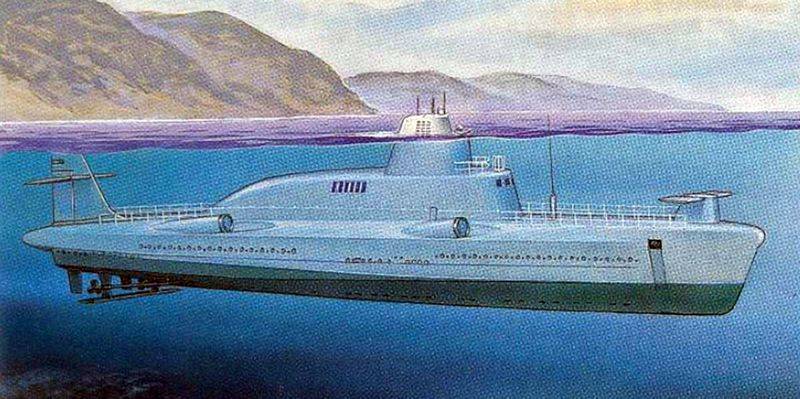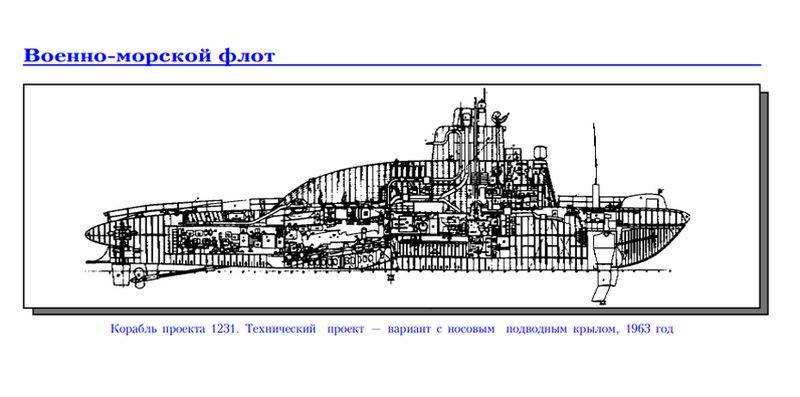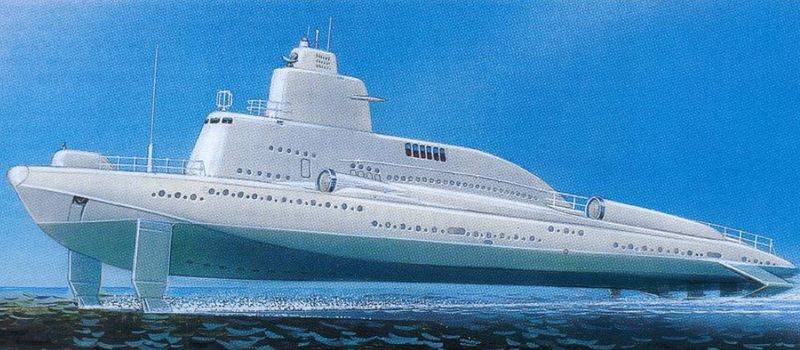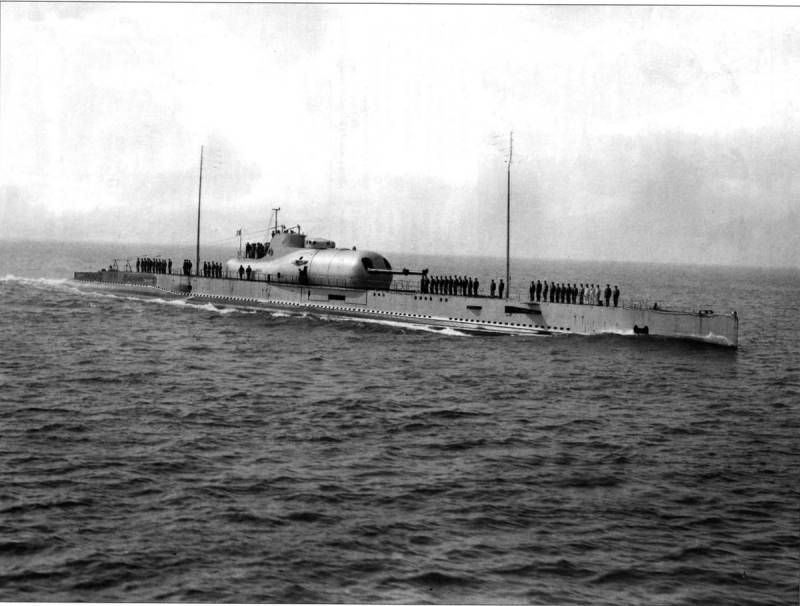Submersible missile boat. 1231 Dolphin Project

The birth of the idea of a diving missile carrier
It is worth noting that Soviet designers were not the first to propose a project that combines the qualities of a surface and submarine ship. The first attempts to create such a ship were made at the end of the XIX century. Despite a fairly large number of projects and ideas, nobody managed to create a surface-submarine ship. Some success in this field of experiment was achieved by the French, who even before the start of World War II had created an unusual submarine - the Sürkuf submarine cruiser, which, besides the torpedo armament typical of submarines, carried a tower with two 203-mm guns on board. The boat, commissioned in the 1929 year, remained one of a kind, holding the record for size and displacement until the very end of World War II. The French did not abandon the idea of creating such ships today. So, in 2010, at the EURONAVALE-2010 exhibition, the project of the battle ship of the future, the diving frigate SMX-25, combining the features of surface combat ships and submarines, was presented.
In the Soviet Union, the idea of creating such a ship was personally submitted by Nikita Khrushchev. Examining the fast boats based in Balaklava (designed by engineers TsKB-5 and TsKB-19) and the submarines located there, the secretary general proposed combining their qualities in a new ship. The idea expressed by Khrushchev was to ensure the secrecy of actions fleet, it was especially important in the conditions of a possible atomic war. Then one of the existing or prospective missile boats decided to "submerge" under water.
The thought expressed by the first person of the state was taken seriously. Specialists of TsKB-19 were invited to work on the creation of a diving missile carrier. The chief designer of the future small submersible rocket ship was the head of the bureau, Igor Kostetsky. The project was planned to be implemented at the Leningrad Marine Plant, which was the construction and experimental base of TsKB-19. Subsequently, after the merger of TsKB-19 and TsKB-5, the project was led by the head of TsKB-5 Evgeny Yukhin. It is believed that the unusual 1231 project “Dolphin” played an important role in combining the two Soviet design bureaus, which later became the Central Marine Design Bureau “Almaz”, which exists today.
It is worth noting that in the pre-war years in the USSR there was a project to create a diving boat. It is believed that the first Soviet designer to introduce such a project was Valerian Brzezinski, who worked in the special technical bureau of the NKVD in 1939. This bureau worked in Leningrad at the factory number 196. The presented project of a submersible torpedo boat received the designation M-400 "Flea". According to the intentions of the developers, an unusual ship was supposed to develop an 33 node speed in the surface position, and 11 nodes in the underwater position. It was planned to equip the boat with a displacement of 35,3 tons with two 450-mm torpedo tubes. The construction of the experimental ship began in Leningrad in 1939 at the A. Marty plant. By the beginning of World War II, the project was completed at 60 percent, but in the conditions of the blockade, the project was frozen, and after damage to the boat as a result of shelling in 1942, it was completely curtailed. According to the developers of "Fleas", the boat was supposed to approach the enemy ships in underwater position, and after a torpedo volley to emerge and exit the battle already in the surface position.
What tasks did Dolphin have to solve?
The main advantage of all submarine warship projects implemented in different years was stealth. Vessels approached the enemy in underwater position, so it was difficult to detect them. At the same time, it was planned to place on board weapon, which was used on conventional surface ships. All projects combined stealth, and sometimes the possibility of underwater use of weapons, characteristic of submarines, with high firepower and speed, like surface combat ships.
The Soviet project of the submersible small missile boat "Dolphin" fit into this concept. According to the plans of the developers, the 1231 project boat was supposed to specialize in delivering sudden missile attacks on warships and transport ships of a potential enemy. It was planned to use small submersible missile boats on approaches to naval bases and large enemy ports, in bottlenecks. It was assumed that the ships would be able to solve the tasks of repelling landings on the coast, will participate in the defense of the coast and the bases of the Soviet fleet, carry out radar and sonar patrols at basing places, operate on enemy sea lanes, interfering with the transport of weapons and cargo.
The creators hoped that a group of missile boats would be deployed in advance in a given area, where they could remain unnoticed by the enemy, while underwater for a long time. Submerging missile boats should also be approaching enemy ships in an underwater position. Approaching the enemy, the ships surfaced and at high speed went to the line of attack. After launching the missiles, the boats were again submerged under water or, having developed the maximum speed, moved away from the battlefield in the surface position. High speed and the ability to dive under water were supposed to reduce the time the ship was under enemy fire and protect the ship from air strikes.
Design Features of the 1231 Dolphin Project Boat
Almost from the very beginning of the design, the main feature of the project was hydrofoil movement, the designers stopped at such a scheme to provide the boat with high speed. At the same time, as part of the work, various options for combinations of the shape of the hull of the boat and hydrofoils were considered. For testing, models were built that were sent to the wind tunnel and the experimental pool, and tests were also conducted on the lake. In total, three main options for the shape of the hull and hydrofoils were presented: without hydrofoils (displacement up to 600 tons), with one nose hydrofoil (displacement 440 tons) and with two hydrofoils (displacement 450 tons). The width of the hull of boats with wings was 9,12 meters, in the version without wings - 8,46 meters. The main differences between the options presented were the surface speed, size and displacement. The length of the options with hydrofoils was a little more than 50 meters, without wings - 63 meters.

During the work, the designers came to the conclusion that the most suitable for development is the project of a small missile boat equipped with one bow wing. This project was chosen even despite the lower speed. Maximum surface speed of 38 nodes versus 42 nodes for the twin-wing variant. Under water, the ship was supposed to develop speed in 4-5 nodes. In favor of this project was that the boat could develop full speed without overloading the main power plant. At the same time, the characteristics of balancing and controllability of the boat in the underwater position were higher than the higher-speed version equipped with two hydrofoils.
During the design process, the designers settled on a model with two compartments located in a durable welded case. In the bow compartment, designers placed the center post of the ship, the posts of acoustics and radio operator, the premises of the electric power industry, as well as the battery pit. It was from this compartment that the commander controlled the missile boat, from here the power plant, missile weapons and radio equipment were controlled. In the second strong compartment were the main engines and electric motors, a diesel generator and other equipment. In the superstructure of the boat, in a separate strong container, the designers located the living compartment of the ship, which had 6 berths (half the crew), a galley, supplies of food and fresh water. In an emergency, the living compartment was planned to be used to save the personnel of the boat from an underwater position. In the event of damage to the living compartment, it was also possible to evacuate from the central post, but already by the method of free ascent to the surface or climbing a buoyer. In the superstructure of the boat was a permeable wheelhouse, which housed the second control station for the main engines of the ship, used in the surface mode.
The main armament of the boat of the 1231 Dolphin project was to be four P-25 cruise missiles, the maximum firing range of which reached 40 kilometers. Missiles were placed in single container-type launchers (sealed), located at a constant inclination to the horizon. All launchers were located outside the sturdy hull of the boat and could withstand the pressure of the maximum depth of the ship. Additional weapons, including air defense systems, were not provided for on the ship. The stake was made on the surprise attack and the speed of withdrawal from the battle.
As a power plant, engineers chose the M507 diesel engine. This unit was a pair of serial engines M504 mastered by the Soviet industry. Fixed-pitch wide-blade propellers were used as propulsion devices on the boat. The design feature of the project was the ability to purge the tanks of the main ballast with the exhaust gases of diesel engines, this solution ensured the rapid ascent of the sinking missile boat.

According to design calculations, all three missile boat options could be submerged to a working depth of 70 meters, the maximum depth was 112 meters. Under water, an unusual ship could be continuously no more than two days. The total autonomy of the boat did not exceed five days. Seaworthiness did not exceed 3-4 points. For hydrofoil variants, the cruising range was 700 nautical miles, in the underwater position - no more than 25 miles. The crew of the boat consisted of 12 people.
The fate of the Dolphin
As experts later noted, the key point in the design of any warship is the planned tactics of its combat use. At the same time, with regard to the submersible small missile boat, such a tactic of application was not comprehensively worked out and studied, especially considering the possible opposition from the probable enemy. The tactical and technical task for the design of a new missile boat was initially not fully justified. The technical characteristics, composition and capabilities of the installed missile weapons obtained during the design of the unique ship allowed the military and designers to better evaluate the combat use of the ship. It became obvious that in real combat conditions the losses of the Dolphins would be no lower than the losses of ordinary surface small missile boats of the Soviet Navy. At the same time, the cost of building ships of the 1231 project would obviously be higher than the cost of building traditional ships, and the military-economic effect of using submersible missile boats was considered doubtful.
The design of a small submersible missile boat was carried out in the USSR from January 1959 of the year to the end of 1964 of the year. After leaving the post of Secretary General Nikita Khrushchev, work was stopped. At the same time, stopping work on the 1231 project was not so much political as a purely practical context. Despite all the dedication of Soviet designers and the consideration of various concepts, the work could hardly have ended successfully. The creation of such ships is associated with insoluble technical problems that arise due to completely different requirements for submarines and surface ships. Previously, none of the projects (the Soviet "Dolphin" was no exception) was brought to its logical conclusion or, like the French boat "Surfuf", was not successful, giving way to specialized ships in everything.

Information